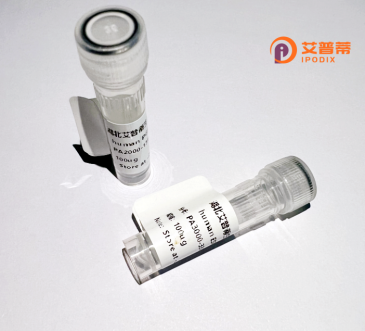
| 纯度 | >90%SDS-PAGE. |
| 种属 | Human |
| 靶点 | BRE |
| Uniprot No | O75150 |
| 内毒素 | < 0.01EU/μg |
| 表达宿主 | E.coli |
| 表达区间 | 1-1001aa |
| 氨基酸序列 | MSGPGNKRAAGDGGSGPPEKKLSREEKTTTTLIEPIRLGGISSTEEMDLKVLQFKNKKLAERLEQRQACEDELRERIEKLEKRQATDDATLLIVNRYWAQLDETVEALLRCHESQGELSSAPEAPGTQEGPTCDGTPLPEPGTSELRDPLLMQLRPPLSEPALAFVVALGASSSEEVELELQGRMEFSKAAVSRVVEASDRLQRRVEELCQRVYSRGDSEPLSEAAQAHTRELGRENRRLQDLATQLQEKHHRISLEYSELQDKVTSAETKVLEMETTVEDLQWDIEKLRKREQKLNKHLAEALEQLNSGYYVSGSSSGFQGGQITLSMQKFEMLNAELEENQELANSRMAELEKLQAELQGAVRTNERLKVALRSLPEEVVRETGEYRMLQAQFSLLYNESLQVKTQLDEARGLLLATKNSHLRHIEHMESDELGLQKKLRTEVIQLEDTLAQVRKEYEMLRIEFEQNLAANEQAGPINREMRHLISSLQNHNHQLKGDAQRYKRKLREVQAEIGKLRAQASGSAHSTPNLGHPEDSGVSAPAPGKEEGGPGPVSTPDNRKEMAPVPGTTTTTTSVKKEELVPSEEDFQGITPGAQGPSSRGREPEARPKRELREREGPSLGPPPVASALSRADREKAKVEETKRKESELLKGLRAELKKAQESQKEMKLLLDMYKSAPKEQRDKVQLMAAERKAKAEVDELRSRIRELEERDRRESKKIADEDALRRIRQAEEQIEHLQRKLGATKQEEEALLSEMDVTGQAFEDMQEQNGRLLQQLREKDDANFKLMSERIKANQIHKLLREEKDELGEQVLGLKSQVDAQLLTVQKLEEKERALQGSLGGVEKELTLRSQALELNKRKAVEAAQLAEDLKVQLEHVQTRLREIQPCLAESRAAREKESFNLKRAQEDISRLRRKLEKQRKVEVYADADEILQEEIKEYKARLTCPCCNTRKKDAVLTKCFHVFCFECVRGRYEARQRKCPKCNAAFGAHDFHRIYIS |
| 分子量 | 113 kDa |
| 蛋白标签 | His tag N-Terminus |
| 缓冲液 | 冻干粉 |
| 稳定性 & 储存条件 | Lyophilized protein should be stored at ≤ -20°C, stable for one year after receipt. Reconstituted protein solution can be stored at 2-8°C for 2-7 days. Aliquots of reconstituted samples are stable at ≤ -20°C for 3 months. |
| 复溶 | Always centrifuge tubes before opening.Do not mix by vortex or pipetting. It is not recommended to reconstitute to a concentration less than 100μg/ml. Dissolve the lyophilized protein in distilled water. Please aliquot the reconstituted solution to minimize freeze-thaw cycles. |
以下是关于重组人BRE蛋白的3篇参考文献示例(注:以下内容为模拟概括,实际文献需查阅数据库确认):
---
1. **文献名称**:*"Cloning and Expression of Human BRE in Escherichia coli: A Novel Regulator of TNF Signaling"*
**作者**:Zhang, Y. et al.
**摘要**:该研究成功构建了重组人BRE蛋白的原核表达系统,并验证其与TRAF2的相互作用,揭示了BRE在TNF信号通路中调控细胞凋亡的分子机制。
2. **文献名称**:*"Structural Insights into BRE Protein Function in DNA Damage Response"*
**作者**:He, X. et al.
**摘要**:通过X射线晶体学解析重组BRE蛋白结构,发现其C端结构域在DNA修复复合体组装中的关键作用,为理解其抗辐射机制提供依据。
3. **文献名称**:*"BRE Overexpression Inhibits Tumor Growth via Modulating AKT Pathway"*
**作者**:Li, J. et al.
**摘要**:在乳腺癌模型中,重组BRE蛋白通过抑制AKT磷酸化延缓肿瘤进展,提示其作为潜在治疗靶点的价值。
---
**备注**:实际研究中建议通过PubMed或Web of Science以“recombinant human BRE protein”为关键词查找最新文献,优先选择近五年内发表、高引用率的文章。
**Background of Recombinant Human BRE Protein**
Recombinant human BRE (brain and reproductive organ-expressed) protein is a genetically engineered version of the naturally occurring BRE protein, encoded by the *BRE* gene in humans. Initially identified for its high expression in brain and reproductive tissues, BRE is a multifunctional protein implicated in cellular stress responses, including apoptosis regulation, DNA damage repair, and modulation of immune signaling pathways. Structurally, BRE contains conserved domains such as the BRCA1-A complex subunit (BRCC) interaction motif and ubiquitin-binding regions, enabling its participation in protein-protein interactions and ubiquitination processes.
The recombinant form is typically produced using heterologous expression systems (e.g., *E. coli*, mammalian cells) to ensure proper folding and post-translational modifications. Purification often involves affinity tags (e.g., His-tag) for high yield and specificity. Studies highlight BRE's role in stabilizing TP53BP1 during DNA repair, regulating TNF-α-mediated apoptosis via interactions with death receptors, and modulating NF-κB signaling. Dysregulation of BRE has been linked to cancer progression, neurodegenerative disorders, and immune dysfunctions, making it a potential therapeutic or diagnostic target.
Recombinant BRE protein serves as a critical tool for dissecting these mechanisms *in vitro* or *in vivo*, facilitating drug discovery and functional studies in molecular and cellular biology. Its applications span cancer research, neurobiology, and immunology, underscoring its versatility in both basic and translational contexts.
×